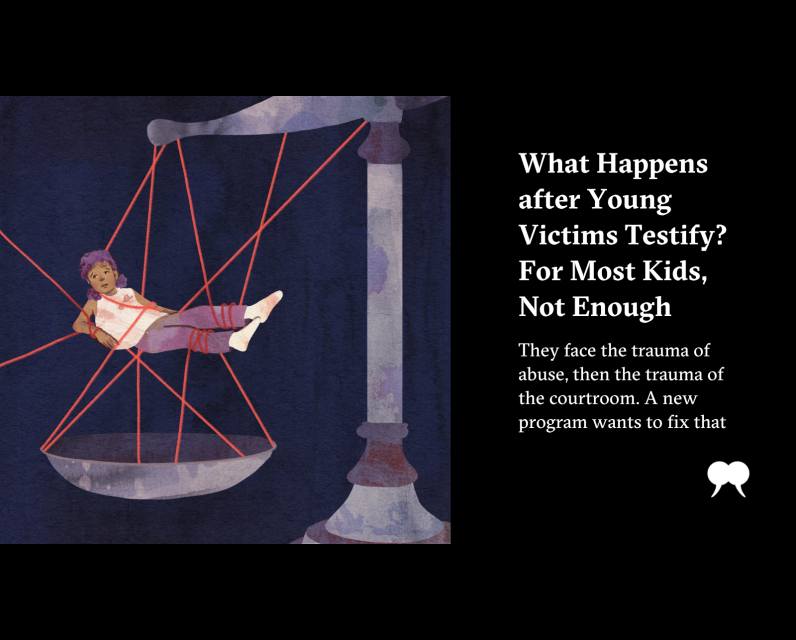What Happens after Young Victims Testify? For Most Kids, Not Enough

“I need support.”
They’ve said this plainly. As if claiming something owed.
Alison Albright hears this often—too often—just moments after a child enters the courtroom and names the people who’ve hurt them. As a social worker in Toronto, she sits beside victims as young as three as they endure the legal system’s cold procedural gaze.
Most days, she’s on Ontario’s Superior Court and Court of Justice, sitting shoulder to shoulder with them as they testify. But the overall image is always an arresting one: young people answering questions they wish to never be asked, in rooms built for adults, with rules that feel like tests. They’re told to speak clearly. To be precise. To repeat the worst parts once again. Sometimes, the person they’re speaking about is sitting just a few feet away.
Albright knows how easily courtroom questioning can twist the truth back onto the child. She witnesses young people freeze mid-sentence, seem inconsistent, or shut down under the weight of cross-examination. “To be questioned in a way where you feel like the most intimate details of your life are being picked apart is excruciating,” she says. “You have the trauma of the abuse you went through, and then you have the trauma of the court process.”
And often, after all that unflinching testimony, it’s not the facts they’ve relayed that make up the worst parts of her job—it’s the plea they’ll often make afterward, woven with the answer she’s forced to give.
“I’m so sorry,” she’s had to say in those moments after testimony. Post-court support for young people doesn’t exist.
Albright’s role was limited to providing support during the court process itself; ongoing therapeutic care or aftercare once the trial ends fell outside her formal responsibilities.
Recognizing this gap, Albright has searched for another program, but it all pointed to the same blank space. Responsibility for providing services for victims is shared across governments, and counselling options vary. Reports from the Rape, Abuse & Incest National Network, or RAINN, the largest anti-sexual violence nonprofit in the US, and Victim Services Ontario make it plain enough: the systems built to prepare kids for criminal court are designed to steady them in crisis. But for the long, quiet work of what comes after, the line is mostly silent.
No formal therapy program in Canada—or anywhere else in North America, to Albright’s knowledge—has ever focused specifically on helping children and youth heal once the courtroom doors close. “There hasn’t been this moment where we all kind of say, collectively: Oh, wait a second. Should we be finished? Is there more to do?” says Albright. But now, a new program is attempting to answer that very question—and to offer what so many children have been told doesn’t exist.
The justice system has always known what to do with the accused. They track arrests, tally charges, and pursue convictions. Care for survivors has rarely figured into that design—in Canada, thousands of children and youth step into courtrooms, carrying stories too heavy for their age. Even well-meaning reforms tend to focus on due process, efficiency, and reducing incarceration, but not recovery. “When the court case is over, everybody who was involved . . . it’s not their role anymore. So the crown attorney, the police officers . . . once the court is concluded, they’ve done their job,” Albright says.
In the 2021/22 fiscal year, 10,665 Canadian youth victims sought support from child and youth advocacy centres—facilities like Calgary’s Luna which provide trauma-informed forensic interviews and court prep. Across the border, in the US, nearly 1,000 children’s advocacy centres served more than 380,000 children in 2023. Yet like Canada, they lack dedicated programs for post-testimony healing—leaving therapeutic care after court patchy and often out of reach.
Governments have made visible investments in youth mental health. In early 2024, Ottawa pledged more than half a million dollars over five years to Halifax’s SeaStar Centre, funding trauma-informed care for child victims of crime for over five years—but when it comes to the quiet aftermath of testimony, long-term support still lags.
The lack of support is proof of a deeper truth: there’s always been a known chasm between how a decades-old institution directs its resources toward perpetrators as opposed to the survivors themselves.
“We’re dealing with very large, complicated systems that were built on some concept of justice that maybe doesn’t fit what people actually go through when they are victims,” says Monique St. Germain, general counsel at the Canadian Centre for Child Protection. “Even if you secure a conviction, that doesn’t mean it’s over. There might have been trauma that happened in the courtroom.”
Her observation underscores a deeper flaw: Canada’s justice system was designed before trauma-informed care, an approach that recognizes how trauma impacts a person’s ability to function or recall events, ever entered the lexicon. Its architecture still treats survivors as witnesses first—the focus is on the accused and the state. Nowhere does this seem more visible than in the pressure some feel to be the “perfect” survivor.
In one case, St. Germain recalled, a teenage girl hesitated to submit an impact statement—not because she didn’t have something to say but because she didn’t think her writing would be “good enough” for the judge. The case involved a sexual offence, and the girl had not attended school past the primary years, making the process feel intimidating. Survivors must write out their experiences, submit them, and then face scrutiny from the Crown and defence, who sometimes fight over what was said, forcing survivors to censor themselves. “That’s a lot to ask of a young person,” adds St. Germain.
“Even a seasoned adult professional undergoing cross-examination is hijacked and under immense stress in that moment,” says St. Germain. “Put yourself in the shoes of a fourteen-year-old trying to convey horrible, humiliating moments, and to then be asked why you did this or didn’t do that.”
Robert Tom Muller, professor and psychologist at York University’s department of psychology and expert in trauma‑focused therapy for children, warns that scrutiny in court “distorts.” He describes the courtroom experience as often “a kind of gaslighting.” “They’re frequently being told: ‘No, that didn’t happen,’ even though they physically lived it.” He adds that flashbacks, triggered by being face to face with an abuser, can manifest as “odd” behaviour—like flat affect, fidgeting, or failing to make eye contact—that judges may misread as evasive or unreliable, deepening the sense of betrayal children carry out of court.
Muller goes further to explain that, for many survivors, the court process “creates the sense of reality being taken from them, a sense of incredible despair about the world, a profound sense of unfairness, disillusionment.”
Toward the latter half of 2024, Albright brought her concerns to the attention of Carly Kalish, chief executive officer of Victim Services Toronto. The conversation was less a revelation and more a confirmation.
“I just didn’t know nothing existed,” says Kalish, who has also long championed trauma-informed care through government advocacy—testifying before Ontario’s legislature in 2024 in support of Bill 188, Supporting Children’s Futures Act, a law aimed at improving trauma support for vulnerable children and youth.
“When [Alison] identified the gap, I was sold immediately.” Together, they agreed that if such services didn’t exist yet, they would build them themselves.
Their shared commitment sparked the creation of Post Court Pathways, a new program designed specifically to support young people, ages three to twenty-five, after they’ve testified in court. Where traditional survivor services end at referrals to other general community or mental health services, its follow-up care is built for the profound injuries of testimony: the bruising that comes from cross-examination, the quiet estrangement that can settle after telling a roomful of strangers what happened to you. It isn’t general counselling. It’s a service that orbits the legal process itself, shifting shape as research deepens and young people name what they still need.
With over $525,000 in fundraising secured, Post Court Pathways now has the chance to become something lasting, though it will need ongoing funding to sustain the program. Its early blueprint includes a literature review of best practices in child trauma care, consultations with legal and psychological experts, and a survivor advisory group made up of young people who’ve lived through the system themselves. While there’s no fixed launch date yet, with the research and development phase still in effect, Post Court Pathways will seek additional support from private donors and potential government funding. When finalized, it will be one of the first of its kind: a model shaped by those who’ve lived it, designed to grow alongside them.
Trauma-informed therapy, of course, undoubtedly exists. But most models are built for ongoing or past wounds—not for the sudden, high-stakes pressure of having to testify in court. Clinicians like Muller have continuously pointed out that the courtroom comes with its own cocktail of stress—legal, emotional, social—that lingers long after the gavel falls. Just as domestic violence survivors lean on advocates who get the rhythms of a particular kind of abuse, young witnesses need specialists who really understand the courtroom’s particular hazards—and how those hazards echo mere hours or days after.
“You can’t just send someone to any trauma therapist,” adds Kalish, reflecting the recommendations of the American Academy of Pediatrics, among others. “You have to send someone to an expert who has expertise in understanding that specific experience of testifying and going through that process.”
In other words, true healing isn’t about plugging someone into another system; it’s about building one with them in mind.
The post What Happens after Young Victims Testify? For Most Kids, Not Enough first appeared on The Walrus.



Comments
Be the first to comment